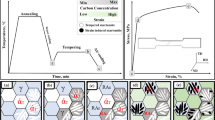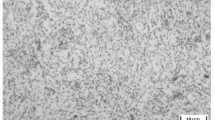Conclusions
-
1.
Ductility properties of the test unstable austenitic steels increase during martensite transformation if it is preceded by plastic deformation of austenite.
-
2.
Maximum ductility of the test steels is obtained with strictly optimum kinetics for martensite transformation which depends on the level of prior deformation. After quenching maximum ductility is obtained with a low intensity of transformation; the ductility peak is observed close to the Md point.
-
3.
After prior deformation maximum ductility corresponds to the greatest intensity of transformation. With an increase in the degree of prior deformation the ductility peak shifts in the direction of lower temperature, and the intensity of martensite transformation corresponding to maximum ductility increases.
-
4.
Martensite transformation may have both a strengthening and a relaxation effect. After quenching steels it mainly develops as a strengthening effect, and after deformation as a relaxation effect.
Similar content being viewed by others
Literature cited
V. Zackey, E. Parker, D. Eahr, and R. Bush, Trans. ASM,60, 252 (1967).
Yu. G. Virakhovskii et al., “Use of martensite transformation caused by deformation for improving the ductility of austenitic steels strengthened by hot working,” Fiz. Met. Metalloved.,32, No. 2, 348 (1971).
I. Ya. Georgieva, “Trip-steels, a new class of high-strength steels with improved ductility,” Metalloved Term. Obrab. Met., No. 3, 18 (1976).
I. N. Bogachev and E. V. Savalei, “Effect of warm working on martensite transformation and the properties of austenitic steels,” Metalloved Term. Obrab. Met., No. 12, 42 (1974).
D. T. Llewellyn and J. D. Merry, “Cold plastic deformation of stainless steels,” in: Highly Alloyed Steels [in Russian], Metallurgiya, Moscow (1969), p. 405.
I. Ya. Georgieva, A. A. Gulyaev, and E. Yu. Kondrat'eva, “Deformation twinning and the mechanical properties of austenitic manganese steels,” Metalloved Term. Obrab. Met., No. 8, 56 (1976).
S. Autolonish and P. Singh, Met. Trans.,2, 2135 (1971).
V. I. Arskii and A. P. Gulyaev, “Microkinetics of martensite transformation,” Fiz. Met. Metalloved.,6, 866 (1958).
I. S. Demchuk and V. I. Krakhmalev, “Inheritance of deformation martensite from the original austenite structure,” Metalloved Term. Obrab. Met., No. 11, 18 (1979).
Additional information
Deceased
Altai Polytechnic Institute, S. M. Kirov Polytechnic Institute. Translated from Metallovedenie i Termicheskaya Obrabotka Metallov, No. 2, pp. 18–21, February, 1984.
Rights and permissions
About this article
Cite this article
Savalei, E.V., Bogachev, I.N. Role of martensite transformation in forming the mechanical properties of unstable austenitic steels. Met Sci Heat Treat 26, 114–119 (1984). https://doi.org/10.1007/BF00707158
Issue Date:
DOI: https://doi.org/10.1007/BF00707158




